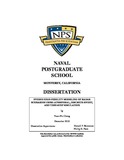Hybrid high-fidelity modeling of radar scenarios using atemporal, discrete-event, and time-step simulation
| dc.contributor.advisor | Brutzman, Donald P. | |
| dc.contributor.advisor | Pace, Phillip E. | |
| dc.contributor.author | Cheng, Yuan-Pin | |
| dc.date | Dec-16 | |
| dc.date.accessioned | 2017-02-09T00:03:10Z | |
| dc.date.available | 2017-02-09T00:03:10Z | |
| dc.date.issued | 2016-12 | |
| dc.identifier.uri | https://hdl.handle.net/10945/51670 | |
| dc.description.abstract | Many simulation scenarios attempt to seek a balance between model fidelity and computational efficiency. Unfortunately, scenario realism and model level of detail are often reduced or eliminated due to the complexity of experimental design and corresponding limitations of computational power. Such simplifications can produce misleading results. For example, Radar Cross Section (RCS) effects in response to time-varying target aspect angle are dominant yet often ignored. This work investigates a new approach. A hybrid, high-fidelity sensor model can be achieved by using a Time-Step (TS) approach with precomputed atemporal response factors (such as RCS), each situated on active simulation entities that interact within an overall Discrete Event Simulation (DES) framework. This work further applies regression analysis to the cumulative results of 1,281 design points multiplied by 100 replications each to provide additional insight from massive results. Through a rigorous cross-validation (CV) for ensuring proper model selection, this new methodology adapts the best aspects of temporal control by each simulation approach, integrating multiple high-fidelity physically based models in a variety of tactical scenarios with tractable computational complexity. The meta-model generates statistically identical results as the baseline hybrid sensor model in mean with higher variation. This outcome sensor model performs in an efficient DES architecture by predicting only probability of detection (Pd) and time-to-detect (TTD) of the targets with the consideration of the range and the aspect relationship between the sensor and the target. The range and the aspect factors were ignored in current existing DES sensor models due to the overly simplified detection algorithm and the constraint of modeling complexity. | en_US |
| dc.description.uri | http://archive.org/details/hybridhighfideli1094551670 | |
| dc.publisher | Monterey, California: Naval Postgraduate School | en_US |
| dc.rights | Copyright is reserved by the copyright owner. | en_US |
| dc.title | Hybrid high-fidelity modeling of radar scenarios using atemporal, discrete-event, and time-step simulation | en_US |
| dc.type | Thesis | en_US |
| dc.contributor.department | Computer Science (CS) | |
| dc.contributor.department | Modeling, Virtual Environments, and Simulation Institute (MOVES) | |
| dc.subject.author | Discrete Even Simulation (DES) | en_US |
| dc.subject.author | radar range equation | en_US |
| dc.subject.author | Simkit | en_US |
| dc.subject.author | Visual Simkit | en_US |
| dc.subject.author | atemporal model | en_US |
| dc.subject.author | hybrid sensor model | en_US |
| dc.subject.author | DES event graph | en_US |
| dc.subject.author | Nearly Orthogonal Latin Hyper Cube (NOLH) | en_US |
| dc.subject.author | regression analysis | en_US |
| dc.subject.author | cross-validation | en_US |
| dc.description.service | Major, The Republic of China, Taiwan Army | en_US |
| etd.thesisdegree.name | Doctor of Philosophy in Modeling, Virtual Environments, and Simulation | en_US |
| etd.thesisdegree.level | Doctoral | en_US |
| etd.thesisdegree.discipline | Modeling, Virtual Environments, and Simulation Institute (MOVES) | en_US |
| etd.thesisdegree.grantor | Naval Postgraduate School | en_US |
| dc.description.distributionstatement | Approved for public release; distribution is unlimited. |
Files in this item
This item appears in the following Collection(s)
-
1. Thesis and Dissertation Collection, all items
Publicly releasable NPS Theses, Dissertations, MBA Professional Reports, Joint Applied Projects, Systems Engineering Project Reports and other NPS degree-earning written works.





